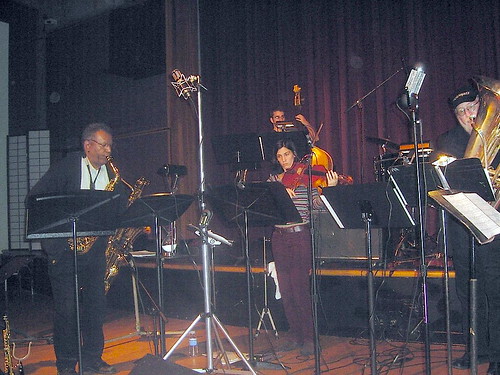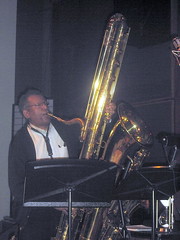Thanks to Jack Krick, I found myself Friday night sitting in the front row of the all-but-sold-out auditorium of
The band area, both on the raised stage & in front, is a forest of music stands – I count ten for the musicians plus one turned at a 90-degree angle to make a table of sorts for an hour glass that Braxton uses to gauge time. Add to this five microphone stands, amplifiers & the various stands for Braxton’s & Bynum’s horns – Braxton’s contrabass saxophone rises up at least nine feet tall – and the image of an electronic forest hardly seems a metaphor.
It has been over twenty years since I last heard Braxton in person (playing with Sam Rivers at the Keystone club in San Francisco, literally next door to the North Beach police station), tho I’ve listened to his music a lot via recordings – after Dylan & the Rova Saxophone Quartet, I may have more CDs (and in the garage, LPs) of Braxton’s than anyone. Never, live or in recording, have I heard him as luminous & articulate as his sextet is tonight.
To call what Braxton does jazz is to use that category historically more than descriptively. Like many of the current generation (he turned 60 on June 4) of jazz-based virtuosos, from the late Steve Lacy to John Zorn, Henry Kaiser, Rova, & many other veterans from Chicago’s Association for the Advancement of Creative Music (AACM), everything is available, from medieval to tribal to blues to classical to post-contemporary. And while improvisation is always close to the heart of what is going on at any given moment, much of the music is scored, even tho the score looks like this:
Or possibly this:
As a leader, Braxton’s style is cerebral, orchestral, even (& this is new I think) avuncular. In his wire-rimmed glasses & trademark cardigan sweater, Braxton signals other musicians with hand gestures that clearly include number – just like a catcher calling for a curve ball – among their elements. At other moments, Braxton would hold up a card & Bynum & the others would thumb through stacks of scores for the right one to raise up to their stands. Only Rozen, a one-time member of the Jerusalem Symphony Orchestra as well as the Austin Klezmorium who was himself the subject once of a composition by Virgil Thompson, is anywhere close to Braxton’s age. Everyone else is in that mid-twenties to early-thirties bracket where scores like the above seem no longer at all unusual or quirky, because they’ve been seeing & playing such their entire lives. Once I watched Bynum “playing” a shape that on his score looked like a pink cartoon drawing of the state of
Braxton has written extensively about his work & musical theories, but often in the most dense prose conceivable:
The subject of narrative form-building and it’s role in creative music is a complex subject that establishes at least four areas of ‘subject-focus’ that can be isolated for discussion, that being: 1) that the base nuclear logic that defines cognition is a tri-centric thought unit that cannot be properly transmitted ( or understood) without some inclusion of a ‘corresponding- poetic’ logic (association/binder) that respects the experiences of the ‘living person’ (the actual ‘experien-cier’). 2) that narrative form building is directly related to the form of evolution that produced the ‘modern-era’ and should not be discarded, 3) that the challenge of the next time cycle transcends two-diminsional modeling constructs and instead calls for a fresh unit of perception that recognizes target ‘sub-level experiences’ ( that included intention, and ‘vibrational-spectra’).¹
What I can see & hear from my vantage, less than three yards from the sextet, is that often – tho not always – Braxton’s “Tri-Centric” music translates into three distinct lines occurring at once. My notebook has jottings like
Sax
violin trumpet tuba
bass vibes
to indicate which combinations functioned when. Over the course of the performance, every possible variation seems to have been explored.
Now Braxton is blowing over his reed, so that you can hear the breath but not the horn (all kinds of resonance with everyone from Charles Olson to Buddhist meditation lurking there) while Bynum is whistling rather in the mode of a theramin (which, at another point, Siegel appeared to be playing, tho I couldn’t fully see it behind the drums & vibes). Krick tells me that Rozen had actually thrown reeds into the bell of his tuba & was thus playing the reeds through the instrument. At another moment Rozen is shaking miniature marimbas or an instrument in the form of a ceramic animal (dog? frog?), Bynum is kicking & spinning & throwing his mutes all over his portion of the performance space, or is on his knees rubbing two small cymbals together.
This is one of those instances where I wish that I had had some formal music training as a child, since what I can’t do here is really explain how cohesive & magisterial this performance was. At 90 minutes, it’s not likely to be released on a current-technology CD, and, as with any live contemporary music event, the room itself is an important factor. The only contemporary music concerts I can think of that were at all comparable in their impact on me were Rova’s performance of The Hive at the old 80 Langston Street performance space in San Francisco that has never been recorded² & the 1974 West Coast premier of Steve Reich’s Drumming in the auditorium of the old Asian Arts Museum in Golden Gate Park, whose acoustics made the event much fuller than the later recording could ever hope to capture. But, just as Drumming was a work that led directly to my poem Ketjak, Braxton’s sextet left me so filled with ideas that I want to think & rethink & dream about that it is certain to get into my poetry, tho you may not be able to see where or when.
¹ From “Narrative Structures.” There is no number 4 in the original.
² Larry Ochs, a member of Rova, swears that The Hive can’t be recorded. The audience was seated in the center of the space – an old brick warehouse – with chairs placed in triangles back to back to back while the musicians moved about the outside perimeter of the room, playing inward toward the audience.
Photos by Jack Krick









